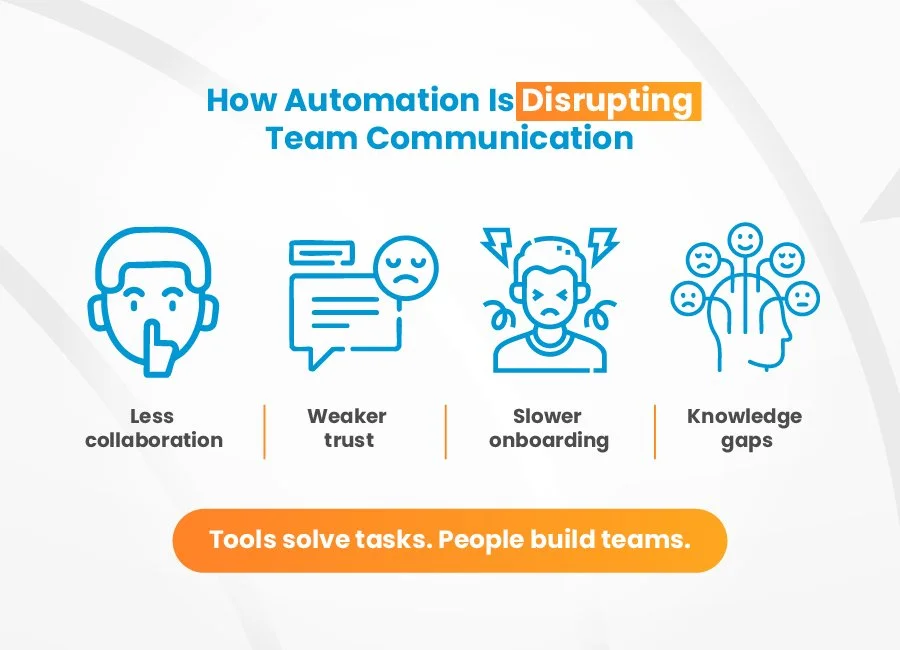The Rise of Cognitive Outsourcing: How AI Is Reshaping Workplace Communication in 2025
Cognitive outsourcing—the practice of consulting AI tools before human colleagues—has become the new workplace norm in 2025. While tools like ChatGPT, project automation platforms, and scheduling assistants increase speed and efficiency, they're also changing how teams communicate, and not always for the better.
65% of knowledge workers now turn to software before asking a colleague, organizations face an unexpected challenge: maintaining meaningful team communication while leveraging AI efficiency. This trend, coined "cognitive outsourcing," saves time but raises new concerns: workplace isolation, weaker collaboration, and declining innovation.
In this article, we explore what cognitive outsourcing means, how it's transforming communication in distributed teams, and what leaders can do to protect connection and culture as AI continues to reshape the modern workplace.
Infographic showing 71% of Millennials use Software before asking a coworker. 50% of Gen Z and Boomer do the Same. 84% of employees using automation say they feel lonely and 89% of Gen Z workers report feeling isolated.
What Is Cognitive Outsourcing and Why Should Leaders Care?
Cognitive outsourcing refers to the growing tendency to offload thinking or problem-solving to digital tools rather than engaging with teammates.
According to a Moo survey:
71% of millennials turn to software first before asking a coworker
50% of Gen Z and baby boomers do the same
84% of members encouraged to use automation at work feel lonely
89% of Gen Z workers report feeling isolated
While technology can be helpful, over-reliance leads to fewer human interactions, missed chances to collaborate, and limited learning across teams, all of which are important in a strong remote work culture.
How AI Automation Is Transforming Team Communication Dynamics
Remote teams have always needed clear communication. But digital tools may now be replacing real conversations. Team members are using software to solve problems, summarize meetings, or plan tasks, skipping team dialogue.
This shift:
Reduces natural collaboration and spontaneous idea sharing
Weakens team trust and shared understanding
Slows onboarding and mentoring for new hires
Creates knowledge gaps and delays in decisions
Additionally, 28% of employees say they’re irritated by coworkers who rely too much on automation, according to Moo’s report. That frustration often comes from reduced collaboration and a lack of context in automated outputs.
Remote team members in video conference meeting demonstrating balanced human collaboration with technology
The Hidden Human Cost of Workplace Hyper-Automation
The push for automation is changing team habits, and not always for the better. Workers encouraged to use digital tools are more likely to describe their culture as stressful, overwhelming, or disconnected.
This pattern reflects broader academic research suggesting that AI adoption in HR practices can improve perceptions of organizational competence, but may simultaneously reduce perceptions of warmth, a key factor in talent commitment and retention.
Leaders must understand that the cost of “cognitive outsourcing” isn’t just fewer conversations, it’s a decline in trust, collaboration, and long-term team success.
5 Strategies to Balance AI Tools with Human Collaboration
Technology doesn’t need to replace human interaction, it can support it, if used carefully. Teams work best when software handles tasks, not relationships.
Ways to keep human connection strong:
Use tools last for creative or strategic tasks: Ask for human input before bringing in digital support.
Create culture routines: Weekly check-ins, async voice notes, and shared wins help teams stay connected.
Protect live collaboration: Block off no-software brainstorming sessions to keep group ownership.
Prioritize onboarding with human connection: Assign mentors, use buddy systems, and set expectations with direct conversation.
Encourage open knowledge sharing: Use tools to capture notes, but ensure people review, add context, and discuss insights.
For more guidance, read Workplace Culture in a Remote Setting.
Building High-Trust Remote Teams in an AI-Driven Workplace
At Projective Staffing, we help companies build remote teams that combine digital efficiency with strong connections. Through strategic hiring, values-matched sourcing, and onboarding support, we make sure your distributed team communicates, collaborates, and grows, without losing its human focus.
Our approach helps prevent overuse of automation by hiring people who match your team and are ready to succeed in a balanced tech-and-human environment. We also prioritize long-term team health, helping you reduce the risk of early termination by aligning talent with work culture and expectations from the start.
FAQs: About AI and Team Communication
What is cognitive outsourcing in the workplace?
It’s when workers use software instead of talking to teammates, reducing connection and shared learning.
How does technology affect team communication?
It can improve speed but also reduce collaboration, create silos, and increase workplace loneliness if not used carefully.
Can digital tools harm company culture?
Yes. Relying too much on automation for communication or decisions can weaken trust and teamwork.
How can leaders balance technology and collaboration?
Use digital tools for tasks, not conversations. Keep human connection strong with onboarding, live meetings, and shared routines.
Build Smarter, More Connected Teams with Projective Staffing
Digital tools will continue to evolve, but people-focused teams will always do better. Projective Staffing helps you design remote hiring and onboarding that uses technology without losing what matters, trust, communication, and team fit.
Let’s build your future-ready team. Book a consultation today.


